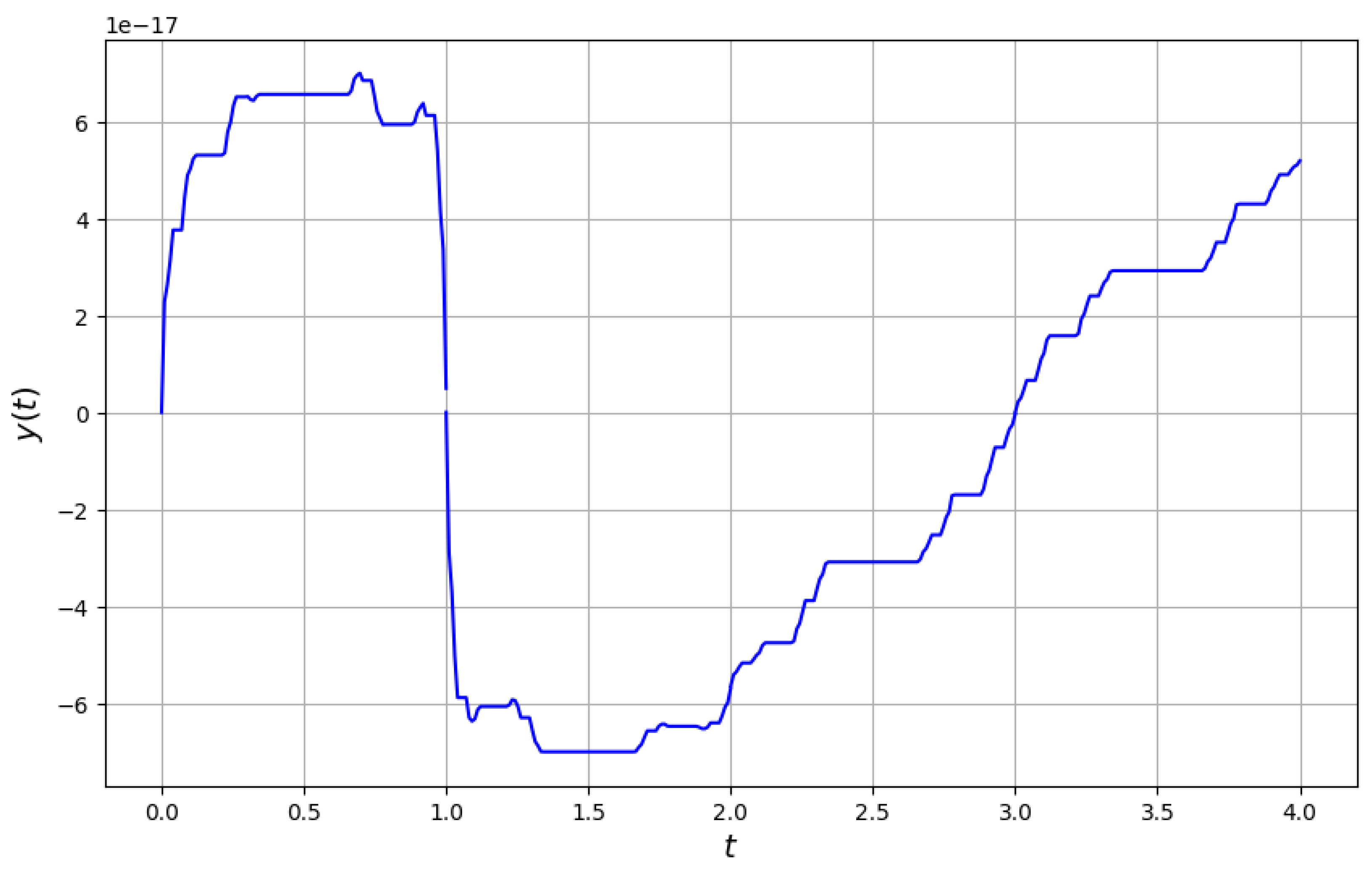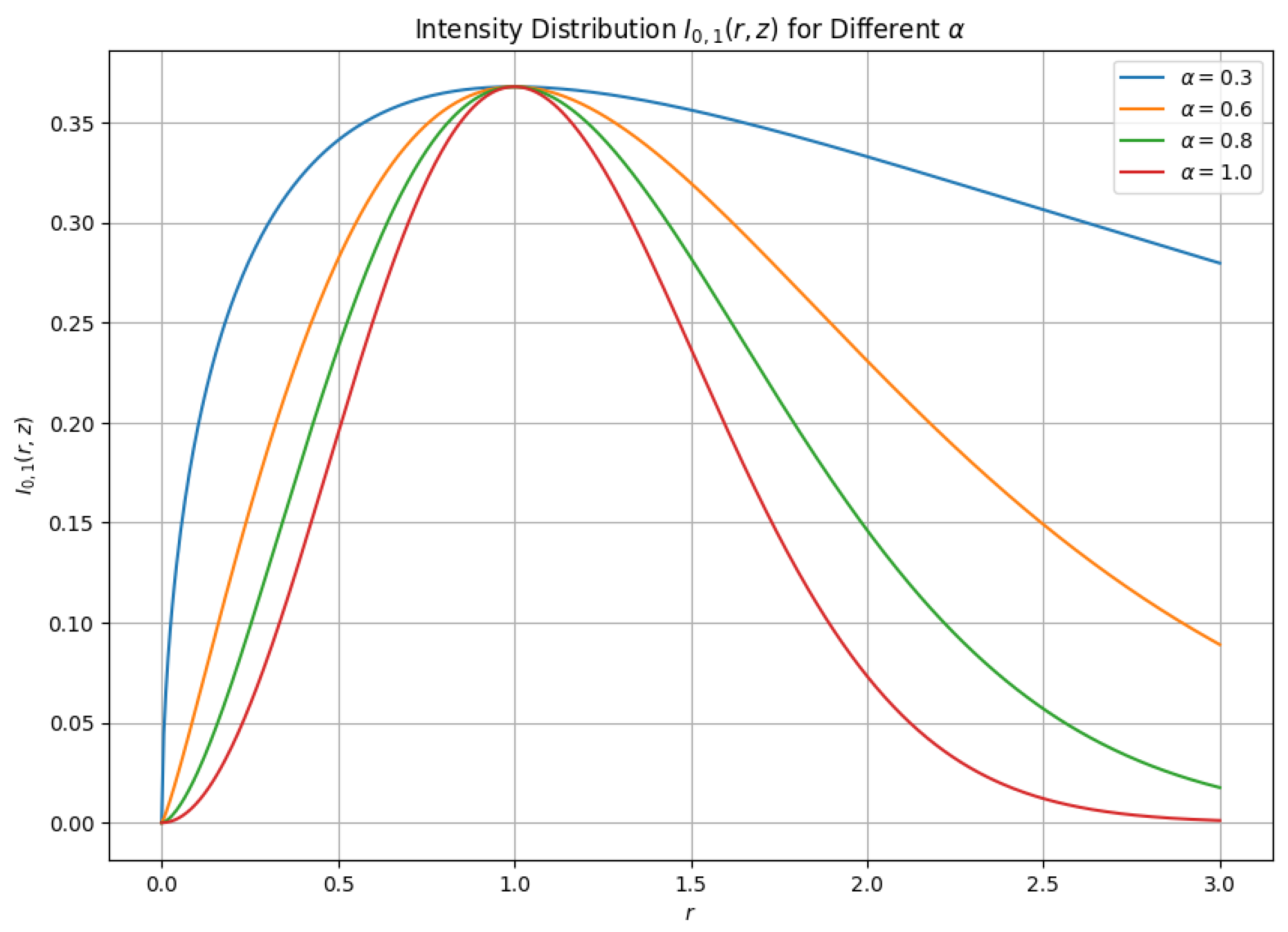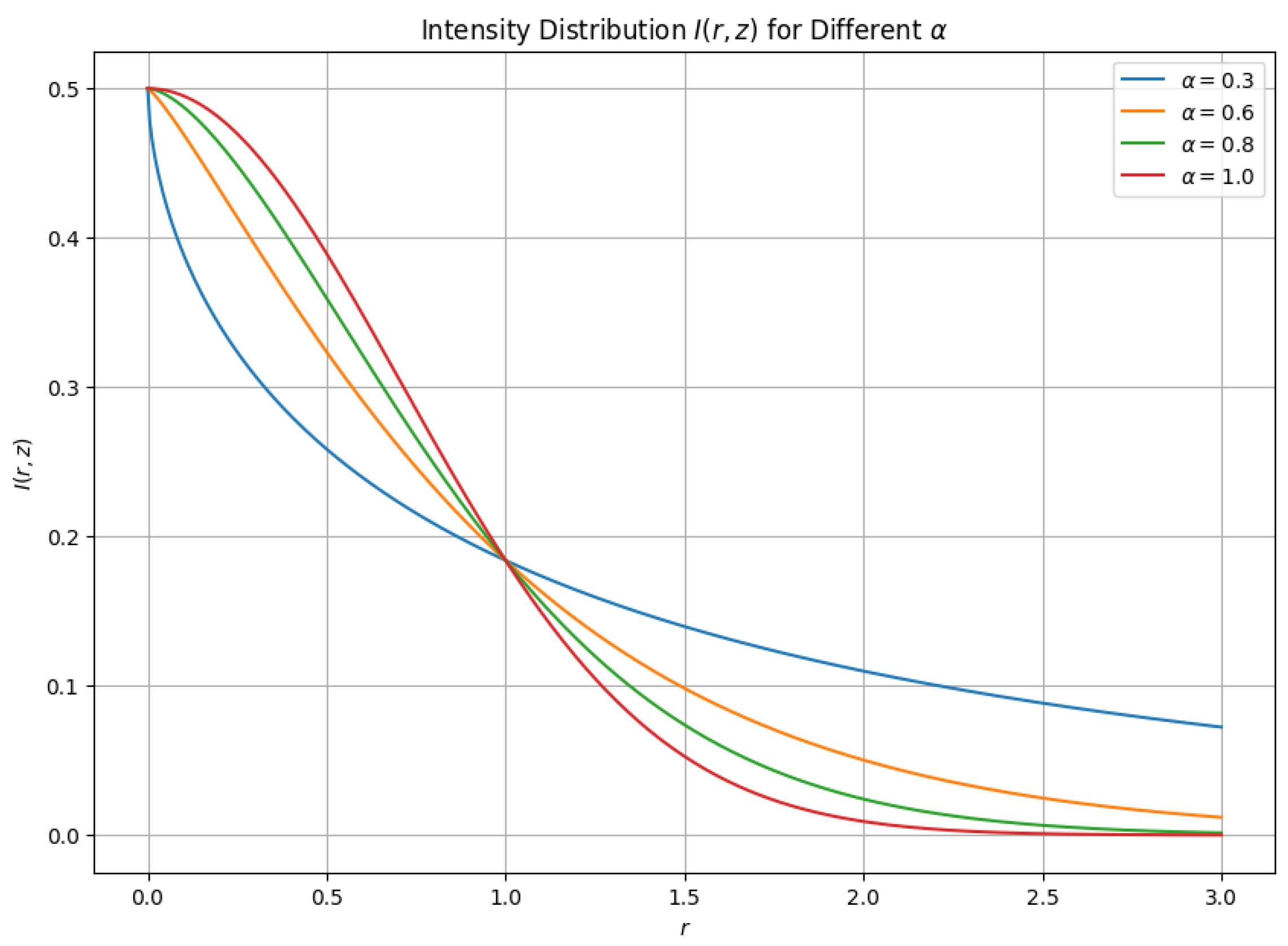Fractal Sturm–Liouville Theory
Abstract
1. Introduction
2. Fractal Calculus Review
3. Generalized Sturm–Liouville Theory
3.1. The Fractal Homogeneous Sturm–Liouville Problem
- Dirichlet: .
- Neumann: .
- Robin:
- 1.
- The fractal Laguerre polynomials are:which are polynomials of degree n.
- 2.
- 3.
- The fractal generating function is as follows:
- 1.
- Bessel function of the first kind :where Γ denotes the Gamma function.
- 2.
- Bessel function of the second kind :which exhibits a singularity at .
- 1.
- Fractal Chebyshev polynomials of the first kind :which are polynomials of degree n.
- 2.
- Fractal Chebyshev polynomials of the second kind :which are also polynomials of degree n.
3.2. The Fractal Nonhomogeneous Sturm–Liouville Problem
- Case 1: for all n: If is not an eigenvalue of the homogeneous problem, then:The solution is then:where
- Case 2: for some m: If , then no solution exists. If , then infinitely many solutions exist of the following form:where is an arbitrary constant, leading to non-uniqueness since any multiple of can be added.The existence of a solution when requires the following:implying that must be orthogonal to the eigenfunction corresponding to the eigenvalue . This formulation provides a systematic approach to solving the fractal nonhomogeneous Sturm–Liouville problem by determining the coefficients and constructing the series solution .
4. Applications
5. Conclusions
Author Contributions
Funding
Data Availability Statement
Conflicts of Interest
References
- Falconer, K. Fractal Geometry: Mathematical Foundations and Applications; John Wiley & Sons: Hoboken, NJ, USA, 2004. [Google Scholar]
- Jorgensen, P.E. Analysis and Probability: Wavelets, Signals, Fractals; Springer Science & Business Media: Berlin/Heidelberg, Germany, 2006; Volume 234. [Google Scholar]
- Mandelbrot, B.B. The Fractal Geometry of Nature; WH Freeman New York: New York, NY, USA, 1982. [Google Scholar]
- Brown, C.; Liebovitch, L. Fractal Analysis; Sage: Newcastle upon Tyne, UK, 2010; Volume 165. [Google Scholar]
- Moreira, O. Fractal Analysis; Arcler Press: Burlington, ON, Canada, 2021. [Google Scholar]
- Kunze, H.; La Torre, D.; Mendivil, F.; Vrscay, E.R. Fractal-Based Methods in Analysis; Springer Science & Business Media: Berlin/Heidelberg, Germany, 2011. [Google Scholar]
- Lowen, S.B.; Teich, M.C. Fractal-Based Point Processes; John Wiley & Sons: Hoboken, NJ, USA, 2005. [Google Scholar]
- Kozlov, G.; Mikitaev, A.K.; Zaikov, G.E. The Fractal Physics of Polymer Synthesis; CRC Press: Boca Raton, FL, USA, 2013. [Google Scholar]
- Feder, J. Fractals; Springer Science & Business Media: Berlin/Heidelberg, Germany, 2013. [Google Scholar]
- West, B.J.; Grigolini, P.; Bologna, M. Fractal Calculus for CERTs. In Crucial Event Rehabilitation Therapy: Multifractal Medicine; Springer: Berlin/Heidelberg, Germany, 2023; pp. 69–83. [Google Scholar]
- Cross, S.S. Fractals in pathology. J. Pathol. 1997, 182, 1–8. [Google Scholar] [CrossRef]
- Sugihara, G.; May, R.M. Applications of fractals in ecology. Trends Ecol. Evol. 1990, 5, 79–86. [Google Scholar] [CrossRef]
- Bunde, A.; Havlin, S. Fractals in Science; Springer: Berlin/Heidelberg, Germany, 2013. [Google Scholar]
- Sandev, T.; Tomovski, Ž. Fractional Equations and Models; Springer International Publishing: Berlin/Heidelberg, Germany, 2019. [Google Scholar]
- Kigami, J. Analysis on Fractals; Number 143; Cambridge University Press: Cambridge, UK, 2001. [Google Scholar]
- Giona, M. Fractal calculus on [0, 1]. Chaos Solit. Fractals 1995, 5, 987–1000. [Google Scholar] [CrossRef]
- Freiberg, U.; Zähle, M. Harmonic calculus on fractals-a measure geometric approach I. Potential Anal. 2002, 16, 265–277. [Google Scholar] [CrossRef]
- Jiang, H.; Su, W. Some fundamental results of calculus on fractal sets. Commun. Nonlinear Sci. Numer. Simul. 1998, 3, 22–26. [Google Scholar] [CrossRef]
- Bongiorno, D.; Corrao, G. On the fundamental theorem of calculus for fractal sets. Fractals 2015, 23, 1550008. [Google Scholar] [CrossRef]
- Contreras, H.; Luis, F.; Galvis, J. Finite difference and finite element methods for partial differential equations on fractals. Rev. Integr. 2022, 40, 169–190. [Google Scholar] [CrossRef]
- Parvate, A.; Gangal, A.D. Calculus on fractal subsets of real line-I: Formulation. Fractals 2009, 17, 53–81. [Google Scholar] [CrossRef]
- Parvate, A.; Satin, S.; Gangal, A. Calculus on fractal curves in ℝn. Fractals 2011, 19, 15–27. [Google Scholar] [CrossRef]
- Golmankhaneh, A.K. Fractal Calculus and its Applications; World Scientific: Singapore, 2022. [Google Scholar]
- Golmankhaneh, A.K.; Cattani, C. Fractal logistic equation. Fractal Fract. 2019, 3, 41. [Google Scholar] [CrossRef]
- Banchuin, R. Noise analysis of electrical circuits on fractal set. COMPEL-Int. J. Comput. Math. Electr. Electron. Eng. 2022, 41, 1464–1490. [Google Scholar] [CrossRef]
- Banchuin, R. Nonlocal fractal calculus based analyses of electrical circuits on fractal set. COMPEL-Int. J. Comput. Math. Electr. Electron. Eng. 2022, 41, 528–549. [Google Scholar] [CrossRef]
- Banchuin, R. On the noise performances of fractal-fractional electrical circuits. Int. J. Circuit Theory Appl. 2023, 51, 80–96. [Google Scholar] [CrossRef]
- Balankin, A.S.; Mena, B. Vector differential operators in a fractional dimensional space, on fractals, and in fractal continua. Chaos Solit. Fractals 2023, 168, 113203. [Google Scholar] [CrossRef]
- Golmankhaneh, A.K.; Bongiorno, D. Exact solutions of some fractal differential equations. Appl. Math. Comput. 2024, 472, 128633. [Google Scholar] [CrossRef]
- Megías, E.; Golmankhaneh, A.K.; Deppman, A. Dynamics in fractal spaces. Phys. Lett. B 2024, 848, 138370. [Google Scholar] [CrossRef]
- Golmankhaneh, A.K.; Ontiveros, L.A.O. Fractal calculus approach to diffusion on fractal combs. Chaos Solit. Fractals 2023, 175, 114021. [Google Scholar] [CrossRef]
- Golmankhaneh, A.K.; Welch, K.; Serpa, C.; Jørgensen, P.E. Fuzzification of Fractal Calculus. arXiv 2023, arXiv:2302.07641. [Google Scholar]
- Golmankhaneh, A.K.; Jørgensen, P.E.; Schlichtinger, A.M. Einstein Field Equations Extended to Fractal Manifolds: A Fractal Perspective. J. Geom. Phys. 2023, 196, 105081. [Google Scholar] [CrossRef]
- Golmankhaneh, A.K.; Welch, K.; Serpa, C.; Rodríguez-López, R. Fractal Laplace transform: Analyzing fractal curves. Int. J. Anal. 2024, 32, 1111–1137. [Google Scholar] [CrossRef]
- Butcher, J.C. Numerical Methods for Ordinary Differential Equations; John Wiley & Sons: Hoboken, NJ, USA, 2016. [Google Scholar]
- Dormand, J.R. Numerical Methods for Differential Equations: A Computational Approach; CRC Press: Boca Raton, FL, USA, 2018. [Google Scholar]
- Cetinkaya, F.A.; Golmankhaneh, A.K. General characteristics of a fractal Sturm-Liouville problem. Turk. J. Math. 2021, 45, 1835–1846. [Google Scholar] [CrossRef]
- Allahverdiev, B.; Tuna, H. Existence theorem for a fractal Sturm–Liouville problem. Vladikavkaz Math. J. 2024, 26, 27–35. [Google Scholar]
- Nuckolls, K.P.; Scheer, M.G.; Wong, D.; Oh, M.; Lee, R.L.; Herzog-Arbeitman, J.; Watanabe, K.; Taniguchi, T.; Lian, B.; Yazdani, A. Spectroscopy of the fractal Hofstadter energy spectrum. Nature 2025, 639, 60–66. [Google Scholar] [CrossRef]
- Al-Gwaiz, M.A. Sturm-Liouville Theory and Its Applications; Springer: Berlin/Heidelberg, Germany, 2008; Volume 264. [Google Scholar]
- Zettl, A. Sturm-Liouville Theory; Number 121; American Mathematical Society: Providence, RI, USA, 2012. [Google Scholar]
- Lützen, J.; Lützen, J. Sturm-Liouville Theory. In Joseph Liouville 1809–1882: Master of Pure and Applied Mathematics; Springer Science & Business Media: Berlin/Heidelberg, Germany, 1990; pp. 423–475. [Google Scholar]
- Amrein, W.O.; Hinz, A.M.; Pearson, D.B. Sturm-Liouville Theory: Past and Present; Springer Science & Business Media: Berlin/Heidelberg, Germany, 2005. [Google Scholar]
- Fattorini, H.O. Second Order Linear Differential Equations in Banach Spaces; Elsevier: Amsterdam, The Netherlands, 2011; Volume 108. [Google Scholar]
- Levitan, B.M.; Sargsyan, I.S. Some problems in the theory of a Sturm-Liouville equation. Russ. Math. Surv. 1960, 15, 1. [Google Scholar] [CrossRef]
- Ames, W.F. Numerical Methods for Partial Differential Equations; Academic Press: Cambridge, MA, USA, 2014. [Google Scholar]
- Arfken, G.B.; Weber, H.J.; Harris, F.E. Mathematical Methods for Physicists: A Comprehensive Guide; Academic Press: Cambridge, MA, USA, 2011. [Google Scholar]
- Richtmyer, R.D.; Burdorf, C. Principles of Advanced Mathematical Physics; Springer: Berlin/Heidelberg, Germany, 1978; Volume 1. [Google Scholar]
- Naimark, M.A. Linear Differential Operators; Harrap: New York, NY, USA, 1968. [Google Scholar]
- Parvate, A.; Gangal, A. Calculus on fractal subsets of real line-II: Conjugacy with ordinary calculus. Fractals 2011, 19, 271–290. [Google Scholar] [CrossRef]
- Zizler, P.; Taylor, K.F.; Arimoto, S. The Courant-Fischer theorem and the spectrum of selfadjoint block band Toeplitz operators. Integral Eqs. Oper. Theory 1997, 28, 245–250. [Google Scholar] [CrossRef]
- Spielman, D. Spectral graph theory. In Combinatorial Scientific Computing; Chapman and Hall/CRC: Boca Raton, FL, USA, 2012; Volume 18. [Google Scholar]
- Golmankhaneh, A.K.; Depollier, C.; Pham, D. Higher order fractal differential equations. Mod. Phys. Lett. A 2024, 39, 2450127. [Google Scholar] [CrossRef]
- Boyce, W.E.; DiPrima, R.C.; Meade, D.B. Elementary Differential Equations and Boundary Value Problems; John Wiley & Sons: Hoboken, NJ, USA, 2021. [Google Scholar]
- Triebel, H. Analysis and Mathematical Physics; Springer Science & Business Media: Berlin/Heidelberg, Germany, 1987; Volume 24. [Google Scholar]
- Serov, V. Fourier Series, Fourier Transform and Their Applications to Mathematical Physics; Springer: Berlin/Heidelberg, Germany, 2017; Volume 197. [Google Scholar]
- Jordan, R.H.; Hall, D.G. Free-space azimuthal paraxial wave equation: The azimuthal Bessel–Gauss beam solution. Opt. Lett. 1994, 19, 427–429. [Google Scholar] [CrossRef]
- Kiselev, A. Localized light waves: Paraxial and exact solutions of the wave equation (a review). Opt. Spectrosc. 2007, 102, 603–622. [Google Scholar] [CrossRef]
- Kimel, I.; Elias, L.R. Relations between hermite and laguerre gaussian modes. IEEE J. Quantum Electron. 1993, 29, 2562–2567. [Google Scholar] [CrossRef]
- Kennedy, S.A.; Szabo, M.J.; Teslow, H.; Porterfield, J.Z.; Abraham, E. Creation of Laguerre-Gaussian laser modes using diffractive optics. Phys. Rev. A 2002, 66, 043801. [Google Scholar] [CrossRef]
- Bennett, C.A. Principles of Physical Optics; John Wiley & Sons: Hoboken, NJ, USA, 2022. [Google Scholar]
- Cocotos, V.; Mkhumbuza, L.; Forbes, K.A.; Koch, R.d.M.; Dudley, A.; Nape, I. Laguerre-Gaussian modes become elegant after an azimuthal phase modulation. arXiv 2024, arXiv:2411.07655. [Google Scholar] [CrossRef]
- Wei, D.; Cheng, Y.; Ni, R.; Zhang, Y.; Hu, X.; Zhu, S.; Xiao, M. Generating controllable Laguerre-Gaussian laser modes through intracavity spin-orbital angular momentum conversion of light. Phys. Rev. Appl. 2019, 11, 014038. [Google Scholar] [CrossRef]
- Plick, W.N.; Krenn, M. Physical meaning of the radial index of Laguerre-Gauss beams. Phys. Rev. A 2015, 92, 063841. [Google Scholar] [CrossRef]
- Valencia, N.H.; Srivastav, V.; Leedumrongwatthanakun, S.; McCutcheon, W.; Malik, M. Entangled ripples and twists of light: Radial and azimuthal Laguerre–Gaussian mode entanglement. J. Opt. 2021, 23, 104001. [Google Scholar] [CrossRef]
- Kovalev, A.; Kotlyar, V.; Porfirev, A. Asymmetric laguerre-gaussian beams. Phys. Rev. A 2016, 93, 063858. [Google Scholar] [CrossRef]
- Ghaderi Goran Abad, M.; Mahmoudi, M. Laguerre-Gaussian modes generated vector beam via nonlinear magneto-optical rotation. Sci. Rep. 2021, 11, 5972. [Google Scholar] [CrossRef]
- Shen, C. Riemann solutions and wave interactions for a hyperbolic system derived from the steady 2D Helmholtz equation under a paraxial assumption. Appl. Math. Lett. 2025, 160, 109320. [Google Scholar] [CrossRef]
- Verma, R.K. Wave Optics; Discovery Publishing House: Delhi, India, 2006. [Google Scholar]
- Fontaine, N.K.; Ryf, R.; Chen, H.; Neilson, D.T.; Kim, K.; Carpenter, J. Laguerre-Gaussian mode sorter. Nat. Commun. 2019, 10, 1865. [Google Scholar] [CrossRef]
- Feng, S.; Winful, H.G. Physical origin of the Gouy phase shift. Opt. Lett. 2001, 26, 485–487. [Google Scholar] [CrossRef]
- Züchner, T.; Failla, A.V.; Meixner, A.J. Light microscopy with doughnut modes: A concept to detect, characterize, and manipulate individual nanoobjects. Angew. Chem. Int. Ed. 2011, 50, 5274–5293. [Google Scholar] [CrossRef] [PubMed]
- Chapple, P.B. Beam waist and M2 measurement using a finite slit. Opt. Eng. 1994, 33, 2461–2466. [Google Scholar] [CrossRef]
- Hariharan, P.; Robinson, P. The Gouy phase shift as a geometrical quantum effect. J. Mod. Opt. 1996, 43, 219–221. [Google Scholar]
- Hiekkamäki, M.; Barros, R.F.; Ornigotti, M.; Fickler, R. Observation of the quantum Gouy phase. Nat. Photonics 2022, 16, 828–833. [Google Scholar] [CrossRef]
- Ji, X.; Dou, L. Two types of definitions for Rayleigh range. Opt. Laser Technol. 2012, 44, 21–25. [Google Scholar] [CrossRef]




Disclaimer/Publisher’s Note: The statements, opinions and data contained in all publications are solely those of the individual author(s) and contributor(s) and not of MDPI and/or the editor(s). MDPI and/or the editor(s) disclaim responsibility for any injury to people or property resulting from any ideas, methods, instructions or products referred to in the content. |
© 2025 by the authors. Licensee MDPI, Basel, Switzerland. This article is an open access article distributed under the terms and conditions of the Creative Commons Attribution (CC BY) license (https://creativecommons.org/licenses/by/4.0/).
Share and Cite
Golmankhaneh, A.K.; Vidović, Z.; Tuna, H.; Allahverdiev, B.P. Fractal Sturm–Liouville Theory. Fractal Fract. 2025, 9, 268. https://doi.org/10.3390/fractalfract9050268
Golmankhaneh AK, Vidović Z, Tuna H, Allahverdiev BP. Fractal Sturm–Liouville Theory. Fractal and Fractional. 2025; 9(5):268. https://doi.org/10.3390/fractalfract9050268
Chicago/Turabian StyleGolmankhaneh, Alireza Khalili, Zoran Vidović, Hüseyin Tuna, and Bilender P. Allahverdiev. 2025. "Fractal Sturm–Liouville Theory" Fractal and Fractional 9, no. 5: 268. https://doi.org/10.3390/fractalfract9050268
APA StyleGolmankhaneh, A. K., Vidović, Z., Tuna, H., & Allahverdiev, B. P. (2025). Fractal Sturm–Liouville Theory. Fractal and Fractional, 9(5), 268. https://doi.org/10.3390/fractalfract9050268






